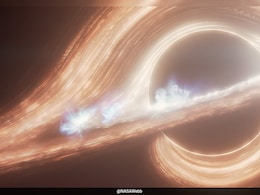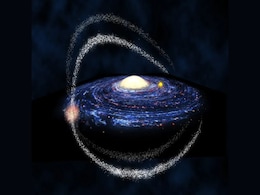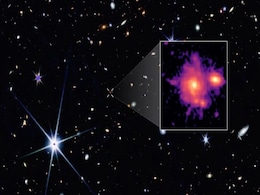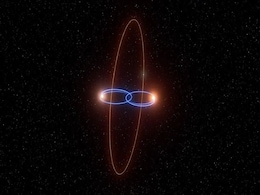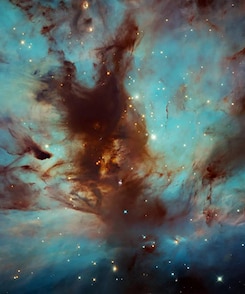Milky Way
- All
- News
- Videos
- Web Stories
-

Scientists Confirm Existence Of First Lone Black Hole In Milky Way
- Monday April 21, 2025
- Science | Edited by Abhinav Singh
Prior to the current finding, all black holes that scientists have ever identified have been spotted with a companion star.
-
 www.ndtv.com
www.ndtv.com
-

Astronomers Discover Potential ‘Dark Galaxy’ Near the Milky Way
- Monday April 21, 2025
- Written by Gadgets 360 Staff
Astronomers have spotted a massive hydrogen cloud near the Milky Way that may be a rare dark galaxy—an object composed of gas and dark matter but lacking stars and light. Detected through radio telescopes, the galaxy-like structure challenges conventional astronomy and could reveal hidden phases of galaxy formation and dark matter interaction in ...
-
 www.gadgets360.com
www.gadgets360.com
-

NASA James Webb Space Telescope Discovers Farthest Spiral Galaxy, Reveals Clues About Galactic Evolution
- Saturday April 19, 2025
- Written by Gadgets 360 Staff
JWST discovers Zhúlóng, the earliest Milky Way-like galaxy, 800 million years after the Big Bang explosion occurred.
-
 www.gadgets360.com
www.gadgets360.com
-

Bizzare 'Failed Star' Planet Orbiting Double Star System in Milky Way Discovered by Researchers
- Thursday April 17, 2025
- Written by Gadgets 360 Staff
Astronomers have discovered an exoplanet 90 degrees tilted around a special pair of eclipsing brown dwarfs. This uncommon "polar planet" challenges accepted wisdom on planet creation by presenting new insights on the dynamics of binary stars and the range of Milky Way planetary orbits.
-
 www.gadgets360.com
www.gadgets360.com
-

NASA’s Hubble Space Telescope Tracks a Neutron Star With Mysterious Origin
- Wednesday April 16, 2025
- Written by Gadgets 360 Staff
NASA’s Hubble Space Telescope spotted a rogue magnetar, dubbed SGR 0501+4516, traversing our galaxy for a significantly long time. As per claims by scientists, it was first discovered in the year 2008 by NASA's Swift Observatory as intense flashes of gamma rays in the outer area of the Milky Way
-
 www.gadgets360.com
www.gadgets360.com
-

Our Neighbouring Galaxy Is Being Torn Apart, Scientists Make Shocking Discovery
- Friday April 11, 2025
- Science | Edited by Abhinav Singh
Scientists made the claim after analysing the data collected by the European Space Agency's recently retired Gaia spacecraft.
-
 www.ndtv.com
www.ndtv.com
-

"Music" Of Starquakes Reveals New Way To Understand History Of Galaxy
- Thursday April 3, 2025
- Science | The Conversation, Emma Shortis
The "music" of starquakes - enormous vibrations caused by bursting bubbles of gas that ripple throughout the bodies of many stars - can reveal far more information about the stars' histories and inner workings than scientists thought.
-
 www.ndtv.com
www.ndtv.com
-

NASA’s SPHEREx Mission Sends First Space Images Before Full Sky Survey
- Thursday April 3, 2025
- Written by Gadgets 360 Staff
NASA’s SPHEREx telescope has captured its first images from space, marking a critical milestone before its full-sky infrared survey begins. The observatory, launched on March 11, recorded thousands of light sources, including distant galaxies and stars. Unlike other space telescopes, SPHEREx is designed for large-scale cosmic mapping, scanning th...
-
 www.gadgets360.com
www.gadgets360.com
-

Space Telescope Gaia Sent Into 'Retirement' But Legacy Endures
- Friday March 28, 2025
- World News | Agence France-Presse
Europe's Gaia space telescope was powered down and sent into "retirement" on Thursday after a decade revealing the secrets of the Milky Way, but its observations will fuel discoveries for decades to come.
-
 www.ndtv.com
www.ndtv.com
-

Energy Signals From Milky Way's Core Could Unveil New Type Of Dark Matter: Study
- Friday March 14, 2025
- Science | Edited by Nikhil Pandey
A new study suggests that clues about dark matter may be hidden in the Milky Way's Central Molecular Zone, where unexplained chemical reactions could be caused by a lighter form of dark matter.
-
 www.ndtv.com
www.ndtv.com
-

Video: NASA Launches SPHEREx Telescope To Explore Universe's Origins
- Wednesday March 12, 2025
- World News | Reuters
A NASA telescope was launched into space from California on Tuesday for a mission to explore the origins of the universe and to scour the Milky Way galaxy for hidden reservoirs of water, a key ingredient for life.
-
 www.ndtv.com
www.ndtv.com
-

New Dark Matter Hypothesis Suggests Ionisation Clue in Milky Way’s Core
- Wednesday March 12, 2025
- Written by Gadgets 360 Staff
Researchers propose that an overlooked dark matter candidate may explain unusual ionisation levels in the Milky Way’s Central Molecular Zone (CMZ). This theory suggests that lightweight, self-annihilating dark matter particles could be producing electrons and positrons, influencing cosmic chemistry. The findings challenge conventional views, offe...
-
 www.gadgets360.com
www.gadgets360.com
-

Study Reveals Evidence of Supermassive Black Hole Inside Nearby Galaxy
- Friday March 7, 2025
- World News | Reuters
A study based on the trajectory of nine fast-moving stars observed at the fringes of the Milky Way provides strong evidence for the existence of a supermassive black hole inside the Large Magellanic Cloud.
-
 www.ndtv.com
www.ndtv.com
-

New Study Reveals How Pulsars Help Measure Dark Matter in the Milky Way
- Tuesday March 4, 2025
- Written by Gadgets 360 Staff
A breakthrough study has used pulsar acceleration data to measure dark matter density in the Milky Way. Previously, binary pulsars were the primary source of data, but now solitary pulsars have been included, doubling the dataset. The research also provides evidence of the Milky Way’s "wobble" due to interactions with dwarf galaxies. By mapping t...
-
 www.gadgets360.com
www.gadgets360.com
-

Scientists Confirm Existence Of First Lone Black Hole In Milky Way
- Monday April 21, 2025
- Science | Edited by Abhinav Singh
Prior to the current finding, all black holes that scientists have ever identified have been spotted with a companion star.
-
 www.ndtv.com
www.ndtv.com
-

Astronomers Discover Potential ‘Dark Galaxy’ Near the Milky Way
- Monday April 21, 2025
- Written by Gadgets 360 Staff
Astronomers have spotted a massive hydrogen cloud near the Milky Way that may be a rare dark galaxy—an object composed of gas and dark matter but lacking stars and light. Detected through radio telescopes, the galaxy-like structure challenges conventional astronomy and could reveal hidden phases of galaxy formation and dark matter interaction in ...
-
 www.gadgets360.com
www.gadgets360.com
-

NASA James Webb Space Telescope Discovers Farthest Spiral Galaxy, Reveals Clues About Galactic Evolution
- Saturday April 19, 2025
- Written by Gadgets 360 Staff
JWST discovers Zhúlóng, the earliest Milky Way-like galaxy, 800 million years after the Big Bang explosion occurred.
-
 www.gadgets360.com
www.gadgets360.com
-

Bizzare 'Failed Star' Planet Orbiting Double Star System in Milky Way Discovered by Researchers
- Thursday April 17, 2025
- Written by Gadgets 360 Staff
Astronomers have discovered an exoplanet 90 degrees tilted around a special pair of eclipsing brown dwarfs. This uncommon "polar planet" challenges accepted wisdom on planet creation by presenting new insights on the dynamics of binary stars and the range of Milky Way planetary orbits.
-
 www.gadgets360.com
www.gadgets360.com
-

NASA’s Hubble Space Telescope Tracks a Neutron Star With Mysterious Origin
- Wednesday April 16, 2025
- Written by Gadgets 360 Staff
NASA’s Hubble Space Telescope spotted a rogue magnetar, dubbed SGR 0501+4516, traversing our galaxy for a significantly long time. As per claims by scientists, it was first discovered in the year 2008 by NASA's Swift Observatory as intense flashes of gamma rays in the outer area of the Milky Way
-
 www.gadgets360.com
www.gadgets360.com
-

Our Neighbouring Galaxy Is Being Torn Apart, Scientists Make Shocking Discovery
- Friday April 11, 2025
- Science | Edited by Abhinav Singh
Scientists made the claim after analysing the data collected by the European Space Agency's recently retired Gaia spacecraft.
-
 www.ndtv.com
www.ndtv.com
-

"Music" Of Starquakes Reveals New Way To Understand History Of Galaxy
- Thursday April 3, 2025
- Science | The Conversation, Emma Shortis
The "music" of starquakes - enormous vibrations caused by bursting bubbles of gas that ripple throughout the bodies of many stars - can reveal far more information about the stars' histories and inner workings than scientists thought.
-
 www.ndtv.com
www.ndtv.com
-

NASA’s SPHEREx Mission Sends First Space Images Before Full Sky Survey
- Thursday April 3, 2025
- Written by Gadgets 360 Staff
NASA’s SPHEREx telescope has captured its first images from space, marking a critical milestone before its full-sky infrared survey begins. The observatory, launched on March 11, recorded thousands of light sources, including distant galaxies and stars. Unlike other space telescopes, SPHEREx is designed for large-scale cosmic mapping, scanning th...
-
 www.gadgets360.com
www.gadgets360.com
-

Space Telescope Gaia Sent Into 'Retirement' But Legacy Endures
- Friday March 28, 2025
- World News | Agence France-Presse
Europe's Gaia space telescope was powered down and sent into "retirement" on Thursday after a decade revealing the secrets of the Milky Way, but its observations will fuel discoveries for decades to come.
-
 www.ndtv.com
www.ndtv.com
-

Energy Signals From Milky Way's Core Could Unveil New Type Of Dark Matter: Study
- Friday March 14, 2025
- Science | Edited by Nikhil Pandey
A new study suggests that clues about dark matter may be hidden in the Milky Way's Central Molecular Zone, where unexplained chemical reactions could be caused by a lighter form of dark matter.
-
 www.ndtv.com
www.ndtv.com
-

Video: NASA Launches SPHEREx Telescope To Explore Universe's Origins
- Wednesday March 12, 2025
- World News | Reuters
A NASA telescope was launched into space from California on Tuesday for a mission to explore the origins of the universe and to scour the Milky Way galaxy for hidden reservoirs of water, a key ingredient for life.
-
 www.ndtv.com
www.ndtv.com
-

New Dark Matter Hypothesis Suggests Ionisation Clue in Milky Way’s Core
- Wednesday March 12, 2025
- Written by Gadgets 360 Staff
Researchers propose that an overlooked dark matter candidate may explain unusual ionisation levels in the Milky Way’s Central Molecular Zone (CMZ). This theory suggests that lightweight, self-annihilating dark matter particles could be producing electrons and positrons, influencing cosmic chemistry. The findings challenge conventional views, offe...
-
 www.gadgets360.com
www.gadgets360.com
-

Study Reveals Evidence of Supermassive Black Hole Inside Nearby Galaxy
- Friday March 7, 2025
- World News | Reuters
A study based on the trajectory of nine fast-moving stars observed at the fringes of the Milky Way provides strong evidence for the existence of a supermassive black hole inside the Large Magellanic Cloud.
-
 www.ndtv.com
www.ndtv.com
-

New Study Reveals How Pulsars Help Measure Dark Matter in the Milky Way
- Tuesday March 4, 2025
- Written by Gadgets 360 Staff
A breakthrough study has used pulsar acceleration data to measure dark matter density in the Milky Way. Previously, binary pulsars were the primary source of data, but now solitary pulsars have been included, doubling the dataset. The research also provides evidence of the Milky Way’s "wobble" due to interactions with dwarf galaxies. By mapping t...
-
 www.gadgets360.com
www.gadgets360.com

